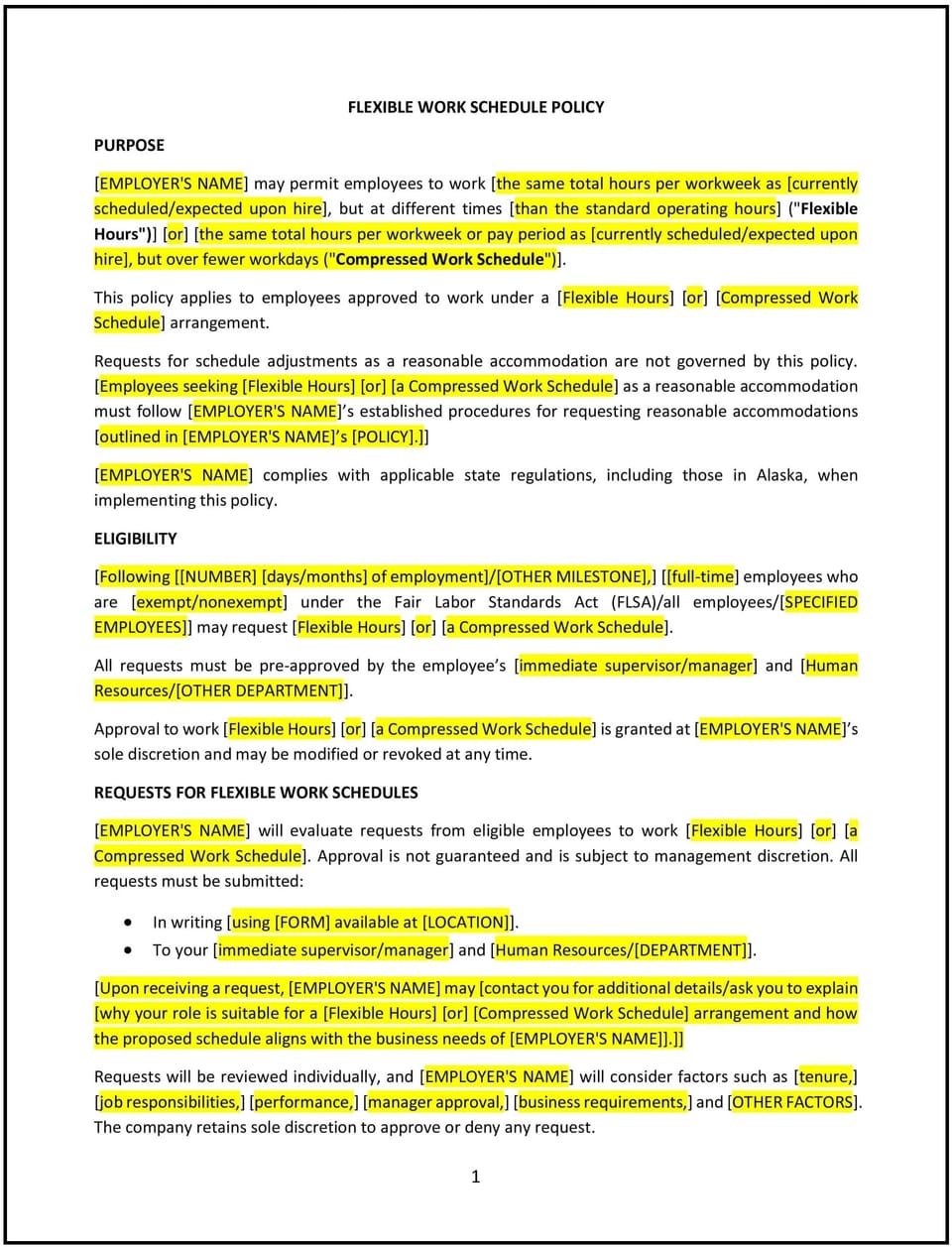Flexible work schedule policy (Alaska): Free template

Flexible work schedule policy (Alaska)
In Alaska, a flexible work schedule policy provides employees with options to adjust their work hours or locations to better accommodate personal needs and improve work-life balance. This policy helps businesses attract and retain top talent, enhance employee satisfaction, and boost productivity.
By implementing this policy, businesses can foster a supportive and adaptable workplace while addressing the unique challenges of Alaska’s workforce, such as remote locations and seasonal work demands.
How to use this flexible work schedule policy (Alaska)
- Define eligibility: Specify which employees or roles are eligible for flexible work schedules based on job responsibilities and operational requirements.
- Outline schedule options: Provide details on available arrangements, such as flexible start and end times, compressed workweeks, or remote work options.
- Establish approval procedures: Include a clear process for employees to request flexible schedules, such as submitting a formal proposal and discussing it with their manager.
- Address accountability: Set expectations for maintaining productivity, meeting deadlines, and communicating effectively while on a flexible schedule.
- Communicate boundaries: Clarify any limitations, such as core hours when employees must be available or restrictions based on business needs.
Benefits of using a flexible work schedule policy (Alaska)
A flexible work schedule policy provides numerous benefits for businesses in Alaska. Here’s how it helps:
- Improves employee morale: Supports work-life balance, leading to higher job satisfaction and engagement among employees.
- Boosts retention: Attracts and retains top talent by offering work arrangements that align with employees’ personal needs.
- Increases productivity: Allows employees to work during their most productive hours, enhancing overall efficiency and output.
- Supports remote work: Addresses the logistical challenges of Alaska’s remote locations, enabling employees to contribute effectively from different settings.
- Enhances operational adaptability: Provides businesses with the flexibility to adjust schedules during seasonal peaks or unexpected disruptions.
Tips for using a flexible work schedule policy (Alaska)
- Tailor to industry needs: Customize the policy to reflect the unique demands of your business, such as seasonal work in tourism or field operations in resource extraction.
- Use technology: Leverage collaboration tools and project management software to support communication and accountability in flexible work arrangements.
- Monitor effectiveness: Regularly review the impact of flexible schedules on productivity, employee satisfaction, and operational efficiency.
- Provide training: Equip managers with the skills to oversee flexible schedules effectively, such as setting goals, tracking progress, and maintaining team cohesion.
- Update as needed: Revise the policy periodically to reflect changes in workforce needs, business operations, or technological advancements.
Q: Which employees are eligible for flexible work schedules?
A: Eligibility depends on job responsibilities and operational requirements. Roles that require in-person tasks may have limited flexibility compared to administrative or remote roles.
Q: What types of flexible work arrangements are covered under this policy?
A: Arrangements may include flexible start and end times, compressed workweeks, remote work options, or part-time schedules, depending on business needs.
Q: How should employees request a flexible work schedule?
A: Employees should submit a formal request outlining their proposed schedule and how they plan to meet job responsibilities. Approval is subject to management discretion.
Q: How does this policy address accountability?
A: Employees on flexible schedules are expected to maintain productivity, meet deadlines, and stay accessible during agreed-upon hours.
Q: How often should this policy be reviewed?
A: The policy should be reviewed annually or whenever significant changes occur in workforce dynamics, technology, or business operations.
This article contains general legal information and does not contain legal advice. Cobrief is not a law firm or a substitute for an attorney or law firm. The law is complex and changes often. For legal advice, please ask a lawyer.


